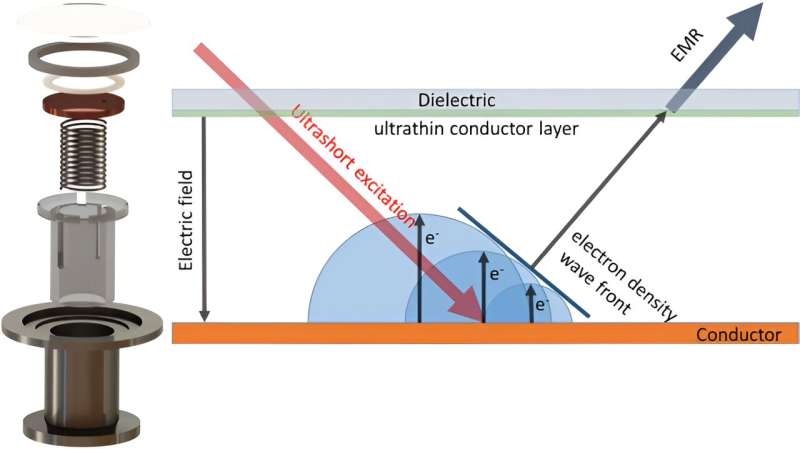This article has been reviewed according to Science X's editorial process and policies. Editors have highlighted the following attributes while ensuring the content's credibility:
fact-checked
proofread
When ultrashort electron bunch accelerates and drastically stops, it can generate terahertz radiation

The propagation of charged particles in a medium at a speed exceeding the phase speed of light in the medium (this speed also called superluminal) leads to the generation of radiation. The diagram of generated radiation during this process has a conical structure. This effect, called the Cherenkov effect, has many fundamental and applied applications, and its explanation was awarded the Nobel Prize in Physics in 1958.
The oblique incidence of light on the interface between two media is a similar phenomenon; in this case, a wave of secondary radiation sources is formed along the interface, which propagates at a speed exceeding the phase speed of light.
The refraction and reflection of light from an interface is the result of the addition of the amplitudes of waves from all sources formed during light incidence. If one considers the interface with photo emissive material—the cathode, on which light is incident obliquely and causes of electron emission—then an electron density wave will form along the cathode surface at superluminal speed.
This phenomenon is accompanied by the generation of secondary radiation. The application of an external electric field leads to the acceleration of electrons and, as a consequence, an increase in the energy of electrons and secondary radiation for such sources.
Researchers from the Prokhorov General Physics Institute of the Russian Academy of Sciences have proposed using the formation of a superluminal wave of electron emission sources to generate terahertz radiation. The study, titled "Pulsed THz radiation under ultrafast optical discharge of vacuum photodiode," has been published in Frontiers of Optoelectronics.
The main idea is to apply ultrashort laser pulses to the surface of the cathode, which leads to the formation of an ultrashort electron bunch. Next, the electrons are accelerated by an external field and abruptly stopped in a thin layer of dielectric, which led to the generation of electromagnetic pulses in the microwave and in the terahertz range.
The authors propose scaling such sources by increasing the efficiency of photo emissive coatings. Results of this work open new sources of THz radiation for tasks of broadband noninvasive tomography, imaging, radar and power effects on electronics.
More information: Aleksandr Ushakov et al, Pulsed THz radiation under ultrafast optical discharge of vacuum photodiode, Frontiers of Optoelectronics (2024). DOI: 10.1007/s12200-024-00123-5
Provided by Frontiers Journals




















